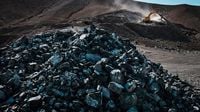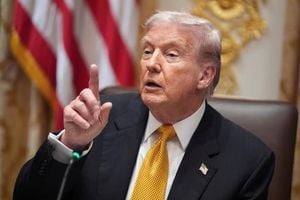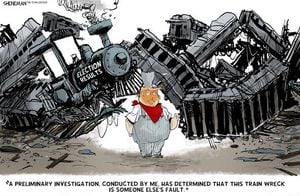Shares of USA Rare Earth (Nasdaq: USAR) soared by 10% in premarket trading on October 3, 2025, after newly appointed CEO Barbara Humpton confirmed ongoing discussions with the White House regarding potential collaborations in the rare earth sector. In a candid interview with CNBC’s Morgan Brennan, Humpton stated, “We are in close communication with the administration,” signaling the company’s openness to working with the Trump administration as the United States scrambles to shore up its supply of critical minerals.
Humpton, who took the helm after a successful stint at Siemens, emphasized the collaborative nature of the rare earth supply chain, remarking, “This is a field where it will not be a zero-sum game. It’s going to take a lot of players to build out this marketplace.” Her comments come at a time when rare earth metals have become essential cogs in the machinery of modern technology—powering everything from electric vehicles and wind turbines to advanced defense systems.
This jump in USAR’s share price is the latest sign of investor enthusiasm as the United States intensifies efforts to reduce its overwhelming dependence on China, which currently controls about 85% of global rare earth processing capacity. According to Invezz, President Trump invoked emergency powers in March 2025 to boost domestic production of critical minerals, a move widely seen as a direct response to the escalating U.S.-China rivalry over technology and resources.
USA Rare Earth’s strategy is ambitious. The company is developing a mine in Sierra Blanca, Texas, and constructing a magnet production facility in Stillwater, Oklahoma, with operations slated to begin in the first half of 2026. The recent $217 million acquisition of Less Common Metals (LCM)—the largest rare earth metals and alloys producer outside China—marks a significant step toward creating a fully integrated, domestic "mine-to-magnet" supply chain. This acquisition will also enable USAR to process recycled materials, aiming for a closed-loop system that recycles manufacturing waste and end-of-life magnets, thereby enhancing sustainability and U.S. independence in rare earth production.
“The deal accelerates the company’s mine-to-magnet strategy, creating an end-to-end domestic supply chain and strengthening US independence in rare earth production,” Humpton told CNBC. That’s not just talk—USAR’s shares have surged nearly 98% in 2025, pushing its market capitalization to approximately $2.59 billion as of early October. Analysts, as reported by Invezz, believe that government backing, strategic acquisitions, and integrated production capabilities could position USA Rare Earth as a linchpin in the domestic rare earth sector.
The Biden administration—now under President Trump—hasn’t been idle either. Earlier this year, the government acquired a 5% stake in Lithium Americas (LAC) and a corresponding share in its Thacker Pass joint venture with General Motors, which is projected to become the largest lithium source in the Western Hemisphere. Additionally, MP Materials finalized a multibillion-dollar agreement with the U.S. government to expand rare earth magnet production, with the Department of Defense now its largest shareholder.
The drive for domestic production comes at a time when China’s own rare earth sector is facing internal challenges. According to a recent analysis by Thant Thura Zan, a research fellow at Yale University, decades of extraction have left China’s southern provinces with depleted reserves of ion-adsorption clays rich in heavy rare earth elements (HREEs). Environmental regulations and tighter production quotas have further restricted output, prompting Chinese processors to look abroad for supplies.
Enter Myanmar’s Kachin State. In 2023, Myanmar supplied nearly 98% of China’s HREE imports, totaling over 9,000 tonnes of concentrates. These heavy rare earths, such as terbium and dysprosium, are crucial for high-temperature permanent magnets used in electric vehicles and defense technology. The Kachin Independence Organization (KIO) and its military wing, the Kachin Independence Army (KIA), now control almost all of Myanmar’s rare earth trade, having consolidated their grip over mining areas by 2024.
Yet, as Zan points out, Myanmar’s role in the global rare earth market is often overstated. While the value of heavy rare earths inflates trade numbers, much of the activity is localized, cross-border commerce rather than broad, stable national output. “Myanmar’s rare earths play a marginal role in China’s rare earth dominance and hold no decisive strategic value for the United States, serving only as a low-cost option when conditions permit,” he writes.
In early 2025, fighting in Kachin briefly disrupted exports to China, causing a spike in prices for dysprosium and terbium. However, China’s rare earth industry quickly adjusted, sourcing from Brazil, Laos, Malaysia, and domestic mines to keep operations running smoothly. This adaptability underscores Beijing’s control over the global rare earth supply chain and its ability to weather regional disruptions.
Amid these dynamics, speculative proposals have emerged. In late July 2025, the Trump administration reportedly floated trial balloons about accessing Myanmar’s HREEs, considering direct engagement with the KIO, the ruling junta, or even routes via India under a QUAD framework. But as Zan notes, “these were trial balloons rather than formal policies,” and the U.S. has rarely engaged with non-state armed groups since the Cold War. India, for its part, has denied reports of attempting to buy rare earth minerals from the KIA, focusing instead on mending ties with China and avoiding new tensions.
For both China and the United States, Myanmar’s rare earths are a convenient bonus—useful when political and market conditions allow, but never a linchpin. The real strategic value lies in robust domestic supply chains and advanced processing capabilities, which the U.S. is now chasing with renewed urgency. As Humpton noted, the rare earth marketplace “is going to take a lot of players to build out,” and the U.S. is determined not to be left behind.
Meanwhile, Myanmar’s rare earth trade holds more significance within its own borders. Control over mining areas shapes internal conflicts and political dynamics, but without strong governance, environmental safeguards, and transparent benefit-sharing, this wealth risks fueling the classic resource curse—a familiar story for resource-rich but politically unstable regions.
As the U.S. ramps up its rare earth ambitions, companies like USA Rare Earth are poised to become central players. With government support, strategic acquisitions, and a focus on sustainability, they could help rewrite the global rare earth playbook—one end-to-end supply chain at a time.






